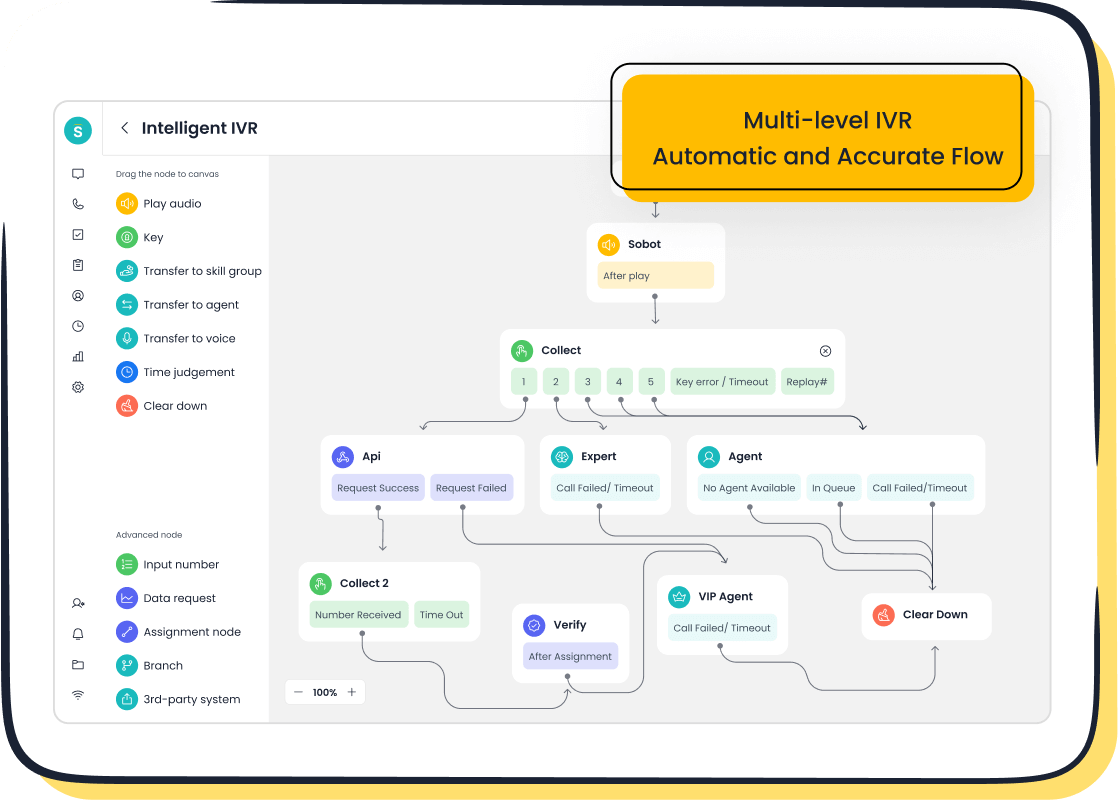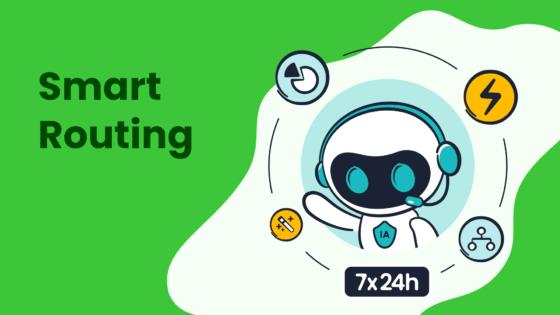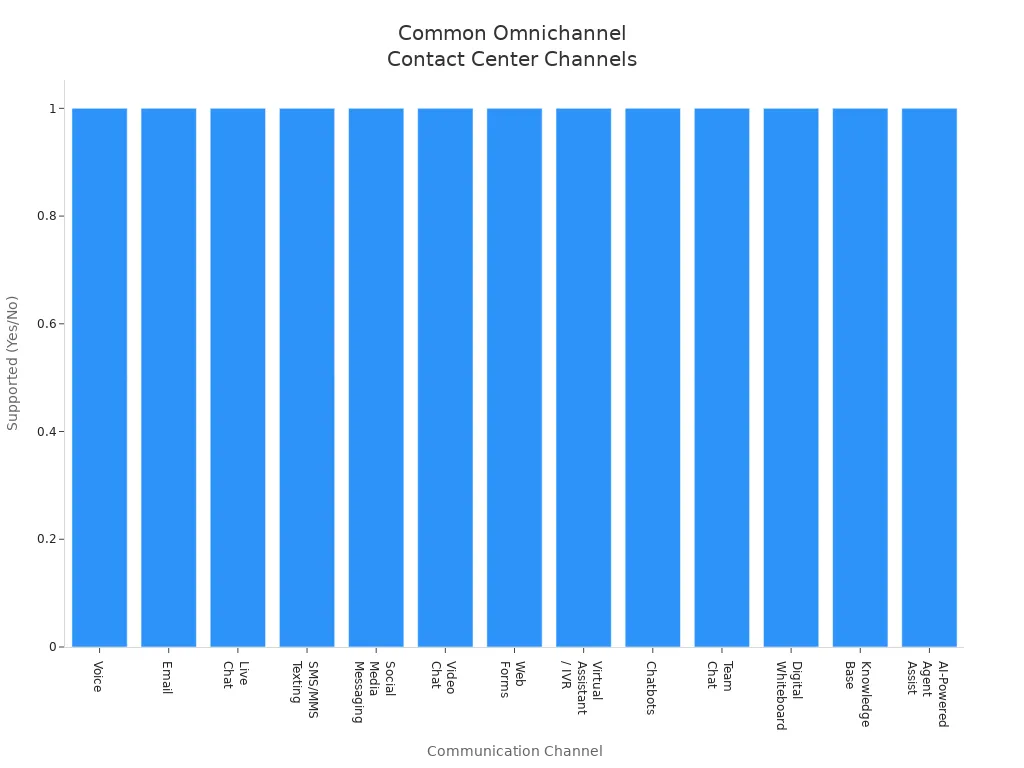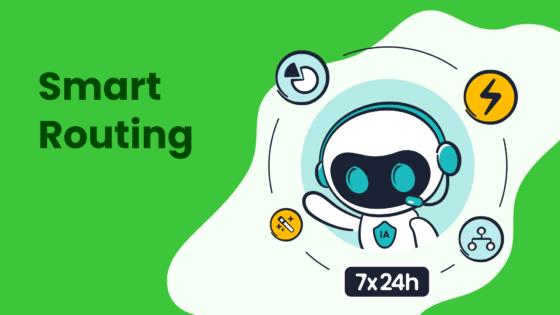What Is an Omnichannel Contact Center Platform and How Does It Work

An omnichannel contact center platform lets companies manage all customer interactions across multiple channels in one place. This platform connects voice, chat, email, and social media, so customers can reach support through their favorite communication channels. Over 90% of businesses now use or plan to use an omnichannel strategy, but only 12% have the right technology in place.

With an omnichannel contact center, customers enjoy seamless service without repeating themselves. Studies show customer satisfaction rises when companies adopt this approach. Sobot, a leader in omnichannel solutions, offers Sobot AI and Sobot call center tools that help unify customer interactions and improve experiences across all channels.
Omnichannel Contact Center Platform

What Is It
An omnichannel contact center platform is a modern solution that brings together all customer communication channels into one unified system. According to industry standards, this type of platform integrates and synchronizes multiple channels, such as voice, email, chat, social media, and messaging apps. The main goal is to give customers a seamless and consistent experience, no matter how they choose to reach out. Agents can see a complete view of each customer’s history and interactions, which helps them provide quick and personalized support.
Omnichannel contact centers have become essential in today’s customer service landscape. Customers expect to connect with businesses through their preferred channels and want smooth transitions if they switch from one channel to another. For example, a customer might start a conversation on live chat, continue it by email, and finish it over the phone. With an omnichannel contact center platform, all these interactions stay connected, so customers never have to repeat themselves.
Sobot stands out as a leader in omnichannel solutions. The company’s platform supports voice, chat, email, and social media, making it easy for businesses to manage every customer interaction in one place. Sobot’s omnichannel cloud contact centers help brands like Opay, Samsung, and Luckin Coffee deliver consistent and high-quality service across the globe.
Note: Research shows that companies using omnichannel contact centers see higher customer satisfaction and loyalty. Customers value the ability to switch channels without losing context or repeating information.
How It Works
An omnichannel contact center platform works by integrating all communication channels into a single, cloud-based system. This integration allows agents to access a unified workspace where they can view customer profiles, past interactions, and real-time updates. The platform uses advanced technology to ensure that every customer interaction is tracked and managed efficiently.
Here is a breakdown of the core mechanics:
| Core Technical Component | Description and Role in Omnichannel Integration |
|---|---|
| Cloud-based Architecture | Enables scalability, remote work, cost savings, and robust security. |
| CRM Integration | Connects customer profiles and interaction history across channels, enabling agents to access unified customer data instantly. |
| Unified Inbox | Consolidates messages from email, chat, SMS, and social media into a single interface, ensuring context continuity. |
| Intelligent Routing | Directs inquiries to the most qualified agents based on skills and availability, ensuring efficient and personalized service. |
| AI-powered Automation | Supports agents with real-time suggestions, chatbots, and conversation summarization to improve response quality. |
| Real-time Dashboards | Provides live monitoring of queues, agent availability, and performance metrics. |
| Call Recording with AI Analytics | Records calls and uses AI to analyze sentiment and quality, enhancing service improvement. |
| Security and Compliance Features | Includes encryption, access controls, automated backups, and audit logging to protect sensitive data. |
Omnichannel cloud contact centers use these components to create a seamless experience for both customers and agents. For example, Sobot’s omnichannel contact center platform offers a unified workspace where agents can manage calls, chats, emails, and social media messages without switching between different tools. The platform’s AI-powered automation handles routine questions, freeing agents to focus on more complex issues.
Unified data management plays a key role in enhancing the customer and agent experience. Centralized customer data ensures that every interaction is consistent and personalized. Agents can see the full history of customer interactions, which helps them respond quickly and accurately. Real-time analytics and insights allow businesses to spot trends and improve service quality. AI features, such as chatbots and predictive routing, help direct customers to the right agent and provide instant answers to common questions.
Here are some ways unified data management benefits omnichannel contact centers:
- Centralized data prevents customers from repeating information, making every interaction smoother.
- Real-time analytics help businesses respond quickly to customer needs.
- Agents have access to complete customer profiles, which improves collaboration and service quality.
- AI and automation handle routine tasks, allowing agents to focus on complex issues.
- Consistent experiences across all channels increase customer loyalty and satisfaction.
Sobot’s omnichannel cloud contact centers use these features to help businesses improve efficiency and reduce costs. For instance, Opay used Sobot’s platform to unify its customer service across social media, email, and voice. This led to a 90% customer satisfaction rate and a 20% reduction in operational costs.
Tip: Companies that use omnichannel contact center platforms can increase agent productivity by up to 30% and improve first-contact resolution rates. Source: Sobot Omnichannel Solution
Omnichannel contact centers also provide strong security and compliance features. Encryption, access controls, and automated backups protect sensitive customer data. Cloud-based security ensures that updates and monitoring happen automatically, reducing the risk of data breaches.
Key Features

Omnichannel Communication
Omnichannel communication lets customers reach a business through many channels, such as phone, email, live chat, SMS, and social media. These channels work together in one system, so customers can switch between them without losing their conversation history. For example, a customer might start a chat on a website, then follow up by email or phone. The agent will see the full story every time. Sobot’s omnichannel customer service solution supports all these channels, making it easy for businesses to connect with customers wherever they are.

Research shows that 89% of people want fast responses. Omnichannel communication helps by shortening wait times and letting agents answer questions quickly. Sobot’s platform uses automation, like chatbots and smart call routing, to handle simple requests and send complex issues to the right agent. This improves customer service and keeps customers happy.
Unified Workspace
A unified workspace brings all customer data and messages into one place. Agents do not need to switch between different apps or screens. Sobot’s unified workspace lets agents see calls, chats, emails, and social media messages together. This setup reduces mistakes and saves time. Agents can greet customers by name and solve problems faster because they have all the information they need. The workspace also helps new agents learn quickly and makes teamwork easier.
Tip: A unified workspace can reduce agent handling time and improve first-contact resolution. Agents can answer questions faster and provide better service.
AI and Automation

AI and automation are key parts of modern omnichannel customer service. Sobot uses AI-powered chatbots to answer common questions right away. These chatbots work 24/7 and can handle many requests at once. If a problem is too hard, the chatbot sends it to a human agent with all the details. AI also helps agents by suggesting answers and tracking customer moods. Sobot’s Voice/Call Center uses AI for smart call routing and voice recognition. Automation takes care of routine tasks, so agents can focus on helping customers with more complex needs.
Analytics
Analytics tools in omnichannel platforms track every customer interaction across all channels. Sobot’s analytics show how long calls last, how fast agents respond, and how happy customers feel. These tools help managers spot problems, like long wait times or common complaints. By looking at this data, businesses can improve their service and fix issues before they grow. Analytics also help companies understand what customers want and how to make their experience better.
Note: Omnichannel analytics give a full view of the customer journey, helping businesses find and fix pain points across all channels.
Customer Experience Benefits
Seamless Interactions
Omnichannel contact center platforms create smooth and connected experiences for customers. These systems bring together all communication channels—phone, email, live chat, SMS, and social media—into one place. Customers can start a conversation on one channel and continue it on another without losing context. Agents see the full conversation history, so customers never have to repeat themselves. This approach reduces frustration and builds trust.
- Omnichannel platforms eliminate friction by keeping all customer information in one system.
- Centralized management improves efficiency and reduces errors.
- Customers enjoy a consistent brand experience across every touchpoint.
- Real-time data helps agents personalize service and meet customer expectations.
- Consistent messaging across channels increases loyalty and satisfaction.
Sobot’s solution helped Opay achieve a 90% customer satisfaction rate, up from 60%. Customers received faster responses and did not need to repeat information, making the customer journey smoother.

Agent Productivity
Omnichannel platforms boost agent productivity by giving them access to unified customer data and smart tools. Agents can see all past interactions, which helps them answer questions quickly and accurately. AI-powered routing connects customers to the right agent, improving first-contact resolution rates. Automation handles routine tasks, so agents can focus on complex issues.
- Unified systems reduce repetitive work and manual errors.
- Chatbots handle simple requests, freeing agents for higher-value service.
- Real-time performance tracking helps agents improve their skills.
- Flexible work arrangements and integrated tools lower stress and reduce turnover.
Sobot’s platform enabled Opay to handle more customer inquiries with fewer errors, increasing productivity by up to 70% and reducing operational costs by 20%.
Data-Driven Insights
Data-driven insights help businesses understand and improve the customer experience. Omnichannel platforms collect and analyze data from every interaction. Managers can track key metrics like response time, customer satisfaction, and agent performance. Real-time analytics reveal trends and highlight areas for improvement.
- Data helps optimize staffing and resource allocation.
- Sentiment analysis shows how customers feel during the customer journey.
- Feedback from surveys and social media guides service improvements.
- Predictive analytics allow agents to anticipate customer needs and offer proactive support.
Sobot’s analytics tools helped Opay reduce errors, improve efficiency, and deliver better customer service. These insights support continuous improvement and higher customer engagement.
Omnichannel vs. Multichannel
Key Differences
Many businesses use either a multichannel or an omnichannel contact center to connect with customers. These two models may sound similar, but they work in very different ways. The main differences come from how each system handles channels, data, and the customer journey.
| Aspect | Omnichannel Contact Center | Multichannel Contact Center |
|---|---|---|
| Channel Integration | Channels are seamlessly integrated to provide a unified experience | Channels operate independently with limited integration |
| Customer Experience | Focuses on delivering a personalized, holistic customer journey | Emphasizes offering multiple channel options without integration |
| Technology | Uses advanced technologies like unified dashboards, omnichannel routing, and cloud infrastructure | Each channel has its own infrastructure; integration is minimal or absent |
| Agent Capabilities | Agents are skilled in multitasking, CRM systems, and managing integrated channels | Agents manage each channel separately, often requiring repeated customer information |
| Efficiency & Automation | Automation and intelligent routing optimize agent productivity and reduce response times | Automation is channel-specific and less integrated |
A multichannel contact center allows customers to reach out through different channels, such as phone, email, or chat, but these channels do not connect. Customers often need to repeat their information if they switch from one channel to another. Agents must manage each channel separately, which can slow down response times and cause frustration.
An omnichannel contact center links all channels together. Agents see the full history of every customer interaction, no matter which channel the customer uses. This integration creates a seamless experience and helps agents solve problems faster. Sobot’s omnichannel contact center platform uses unified dashboards and cloud technology to keep all data in one place, making it easy for agents to deliver consistent service.
Why Omnichannel Wins
The omnichannel contact center stands out because it creates a smooth, connected customer journey. Research shows that companies using an omnichannel strategy see higher customer satisfaction and loyalty. For example, a study in the retail sector found that integrated customer service and seamless experiences lead to better satisfaction and repeat purchases.
- Omnichannel platforms provide real-time data and personalized service.
- Customers do not need to repeat information when switching channels.
- Businesses can track the entire customer journey and spot trends quickly.
- Consistent service across all channels builds trust and loyalty.
Companies like Starbucks and Walmart have seen higher sales and customer retention after adopting an omnichannel approach. Sobot’s omnichannel contact center helps businesses achieve similar results by centralizing data and automating routine tasks. This approach not only improves customer satisfaction but also increases agent productivity and reduces costs. A unified system ensures that every customer feels valued and understood, which leads to long-term business success.
Implementation with Sobot
Getting Started
Deploying Sobot’s omnichannel software begins with understanding the customer journey. Businesses should map out where customers interact with support, such as live chat, phone, or social media. This helps identify which tasks can be automated, like password resets or order tracking. Sobot’s platform brings all these channels together in one place, making it easier for teams to manage customer conversations.
A mid-sized business can follow these steps to get started:
- Map the customer journey and highlight areas for automation.
- Focus on automating high-volume, repetitive tasks.
- Assess current technology and team skills.
- Set clear goals and choose tools that fit business needs.
- Train the team to use automated systems and handle escalations.
- Select features like chatbot automation, live chat, and WhatsApp Business API.
- Gather customer feedback and update the strategy as needed.
Sobot’s AI-powered platform supports multiple languages and offers smart engagement tools. These features help businesses improve customer satisfaction and scale operations.
Best Practices
To get the most from Sobot’s omnichannel software, businesses should focus on integration, training, and ongoing improvement. Integration works best when all customer data is unified. Sobot’s system connects with CRM tools, so agents see a complete view of each customer. Training is key. Teams should learn how to use automation and handle complex customer needs.
Continuous improvement relies on analytics. Sobot provides dashboards that track key metrics like response time and customer satisfaction. Managers can use this data to spot trends and make changes. Regular feedback from customers helps refine the process. Teams should celebrate successes and keep learning new skills.
Tip: Regularly review performance data to find areas for improvement and keep customer service strong.
Overcoming Challenges
Businesses may face challenges like disconnected channels or data silos. These issues can lead to inconsistent customer experiences. Sobot helps solve these problems by using cloud-based tools and APIs to connect different systems. Customer Data Platforms (CDPs) bring all information together, making it easier to analyze and act on customer needs.
Maintaining data quality is important. Sobot uses machine learning to keep customer data accurate and up to date. As customer data grows, the platform scales to handle more information. Sobot’s support team offers resources to help businesses reduce response times and improve ticket resolution rates. This leads to cost savings and better customer support.
Note: Using Sobot’s analytics and automation, businesses can improve customer satisfaction and keep operations running smoothly.
Adopting an omnichannel contact center platform like Sobot brings real results. Companies see higher sales, better first-contact resolution, and lower support costs. Sobot’s platform supports global brands and delivers scenario-based AI for every channel.
| Business Outcome | Impact |
|---|---|
| Sales Conversions | Over 30% increase during campaigns |
| First-Contact Resolution Rate | More than 54% improvement |
| Support Cost Reduction | Up to 50% savings in labor and time |
| Customer Loyalty | Trusted by Samsung, OPPO, and OPay |
Sobot’s omnichannel contact center platform helps businesses grow, improve customer experience, and work more efficiently. Explore Sobot’s solutions to start your own contact journey.
FAQ
What is an omnichannel contact center platform?
An omnichannel contact center platform connects all customer communication channels, such as phone, email, chat, and social media, into one system. This setup helps agents see every interaction in one place. Sobot offers this unified approach to improve customer service and efficiency.
How does Sobot ensure data security in its omnichannel contact center platform?
Sobot uses encryption, access controls, and automated backups to protect customer data. The platform meets strict security standards and maintains a 99.99% uptime. These features help businesses keep sensitive information safe while using Sobot’s omnichannel contact center platform. Learn more.
Can Sobot’s omnichannel contact center platform integrate with existing CRM systems?
Yes, Sobot’s omnichannel contact center platform integrates easily with popular CRM systems. This integration allows agents to access customer profiles and history instantly. Businesses can manage all customer data in one place, which improves response times and service quality.
What are the main benefits of using an omnichannel contact center platform?
An omnichannel contact center platform increases customer satisfaction, reduces costs, and boosts agent productivity. For example, Opay improved its customer satisfaction rate from 60% to 90% after using Sobot’s solution. Unified data and automation help businesses deliver faster, more personalized service.
How does AI help in an omnichannel contact center platform?
AI in an omnichannel contact center platform answers common questions, routes calls, and analyzes customer moods. Sobot’s AI-powered chatbots and voicebots work 24/7. These tools let agents focus on complex issues and help customers get quick answers. See Sobot’s AI features.
See Also
Comprehensive Overview Of Omnichannel Call Center Platforms
Step-By-Step Process For Deploying Omnichannel Contact Centers
Best Cloud-Based Contact Center Services Reviewed For 2024
